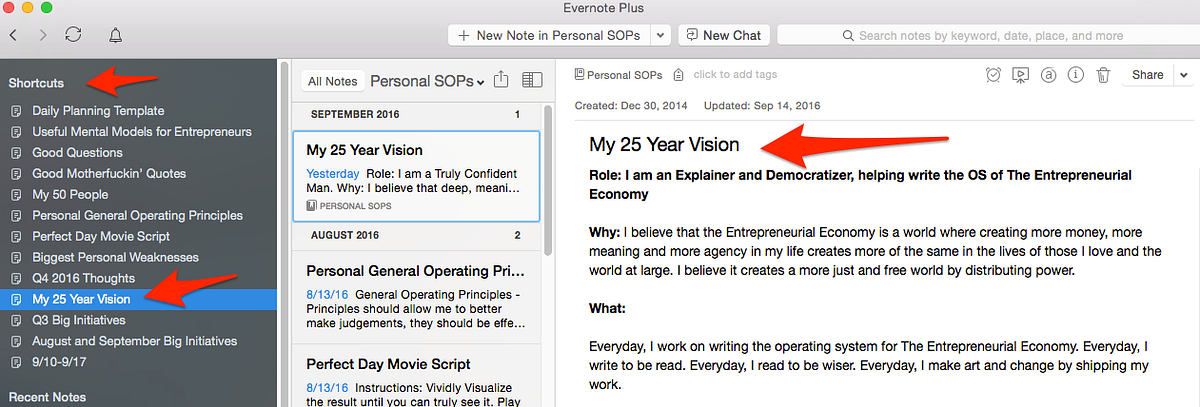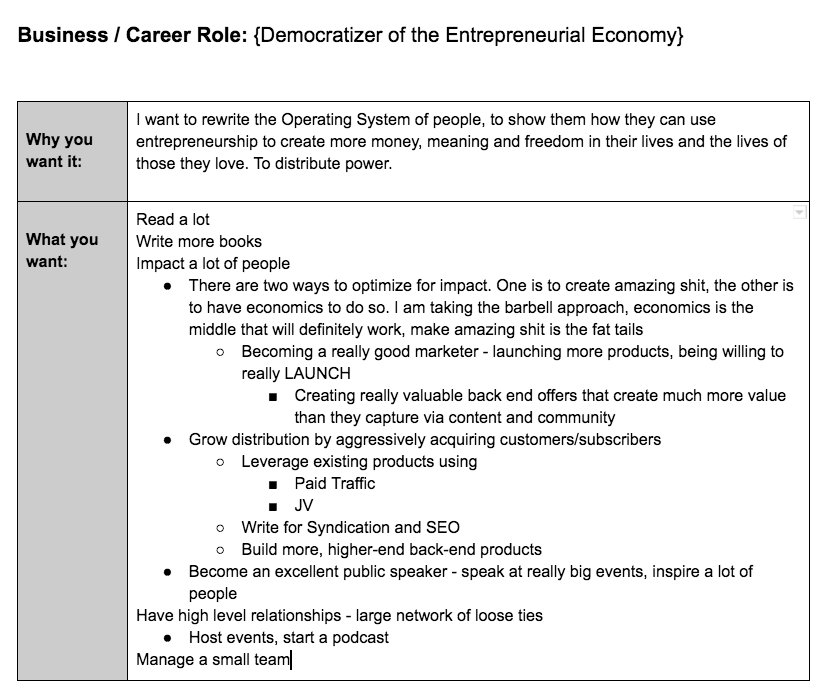
If you haven’t already, read parts one and two of this series.
Science Fiction author and futurist Arthur Clarke observed that there are two hazards of prophecy:
- failure of nerve
- failure of imagination
In 2012 I was working as a project manager at a boutique marketing agency in my hometown. I had a five year goal that I would be able start doing my job remotely or branch out and freelance so I could travel more. I was able to do that within 6 months.
Looking back on what’s happened in the intervening years, the possibilities and opportunities I’ve been exposed to were beyond even my wildest dreams when I began.
In 2012, I was mainly suffering from a failure of imagination. While there are legitimate obstacles that hold people back, often times the biggest one is our own conception of what is possible.
Over the last few years I have made a habit of sitting down every three to six months to just think about what is possible. I’ve developed a system to help me work through that question that I’d like to share here.
The Power of a 25 year Vision
The first step in the system is to craft a 25 year vision. 25 years is somewhat arbitrary so if that feels too long, pick whatever amount of time is as far out into the future as you’re comfortable with (five and ten years are fine).
In a previous article, How To Get Focused, I talked about why I think a long-term vision is important.
For one, it’s motivating. A study by Vallacher and Wegner (1987) found that higher levels of meaning and motivation were consistently marked by longer time frames.
By starting with a longer time frame, you can connect the work you are doing today to something more meaningful and inspiring.
It can also help you identify new, better opportunities by priming yourself to see the world through a certain lens.
The final reason is that having a long-term vision can help with failures of imagination. When you set 1 year or even five year goals, there is a sense that time is running out and “I won’t be able to make it.” One of the biggest mistakes I’ve made and see others make is starting to think about how to accomplish the thing before just laying out what they want.
The result is that a sort-of subconsciously sabotage where you think “Oh I could never do that” and don’t even write it down. If you write it down, you might discover it’s more achievable than you initially thought.
By giving yourself a longer timeframe, like 25 years, you’re more likely to root the things you really want to do out of your head and avoid a failure of imagination.
How to Craft Your 25-Year Vision
I’m going to walk through this exercise for your work life.
For crafting our vision, we’re going to use one question:
“If you were reading this twenty five years from today, and reflecting on the events of those twenty five years, what has to have happened in your professional life for you to feel successful?”
Before you get started on the answer, there is one important guideline:
- This should feel totally impossible and saying it out loud should feel embarrassing.
- As I mentioned before, one of the biggest mistakes people make is to start trying to figure out the “how” before they set the vision, and when they can’t immediately think of a way to accomplish their goal, they throw it out.
- They end up setting goals which aren’t meaningful and exciting enough to keep them motivated so they end up quitting. Counterintuitively, if they’d set bigger goals, they would have been more likely to achieve them, not less.
A Business/Career Example
Let’s walk through the exercise.
Step 1: Download or Copy the template here and scroll down to page 4 of the template.
Respond to the question above: “If you were reading this twenty five years from today, and reflecting on the events of those twenty five years, what has to have happened in your professional life for you to feel successful?”
List everything you can think of.
Remember: Do not start thinking about how to make it happen. It’s essential to keep all these steps separate. If you start to think about “how do I do this,” you will start to make compromises because the vision might sound outlandish.
That’s why I like 25 years rather than one or three years, because it gives you so much time that you can think really expansively.
It’s also important to be honest with yourself. If you want to own a $250k sports car, write that down. I’d like to write a New York Times bestselling book. Is it vain and status seeking? Yes. Will it make me happy if I do it? Nope. But, I still think it would be cool, so it goes on the list.

Once you feel like you have a good list, move onto step two.
Step 2: For each of your aspirations, list what challenges need to be overcome
These challenges are weaknesses or problems that could hold you back.
For each challenge, ask the “5 Whys.” The 5 Whys is a heuristic developed by Toyota that predicts that the root of a problem is usually 5 Whys away from the first thing you say. For example:
The vehicle will not start. (the challenge)
Why? — The battery is dead. (first why)
Why? — The alternator is not functioning. (second why)
Why? — The alternator belt has broken. (third why)
Why? — The alternator belt was well beyond its useful service life and not replaced. (fourth why)
Why? — The vehicle was not maintained according to the recommended service schedule. (fifth why, a root cause)
Applying this strategy to one of the barriers to a given listed goal, looks like this:

You don’t have to get all the way to 5 Whys for each one, but go as far as you can to look for deeper root causes.
Step 3: What opportunities need to be captured
These are advantages in the external environment, things you need to be leveraging to move you towards the goals you listed above.
So for “write a lot of books” as a goal, one opportunity might be “blocking off an hour every morning to write.”
This can just be a running list of everything that comes to mind and doesn’t need to be sorted by goal like in the challenges section.

Step 4: What strengths need to be leveraged?
These are things that you are naturally good at which can help you get to the goals you have listed.

Note: The line between strengths and opportunities is fuzzy and it doesn’t really matter which category you put your responses in. It’s useful to ask both though since you will probably think of things for one that you wouldn’t have if you had just asked the other.
Step 5: Create a 25-year vision document.
This is something that you can refer back to which is both motivating and primes you to spot opportunities.
Format the document in three sections, as follows:
Role — This is a definition of what someone living your chosen life would be called. How would you describe them if they being written about in a history book? Or, how would you give their bio if they were being introduced as a speaker? Look for words in your response above which emotionally resonate.
Why you want it — Why is this goal meaningful and exciting to you? What’s the best thing that could happen?
What you want — What does it look like and feel like on a day-to-day basis? What does someone who has already achieved this do on a day-to-day basis? These are going to be pulled from the Challenges, Strengths, and Opportunities sections. What are the core activities you listed there that need to be managed going forward?
You should be emotionally excited by reading this document, if you’re not, you need to do the exercise over again and really focus on being honest with yourself and not shy about what you’re saying.
Step 6: Copy this document somewhere you can read it every morning.
This is the easiest one to do and the one many people skip. Either print out this one page summary or copy it somewhere on your computer or phone that you look everyday.
I keep mine in my Evernote shortcuts so I can read it on my computer when I’m at home or phone when I travel.

What if I change my mind? What if I don’t know what I want in 25 years?
“The process of planning is very valuable, for forcing you to think hard about what you are doing, but the actual plan that results from it is probably useless.” — Marc Andreessen
You aren’t bound by this document — creating it is an exercise to help get clarity and think about what’s possible. After that, you will want to revise it. If you think about what you would have responded to this question five years ago, it’s likely very different than what you just came up with.
The example I gave here is a personal one from over a year ago and I feel differently about almost all of the things I put down, but it was still a very useful exercise.
I felt more motivated because I could see how the work I was doing led to a vision that I believed was important and inspiring. I saw new opportunities that I might not have otherwise identified because I was able to use my 25 year vision to prime myself.
I’ll do this exercise at the start of every new business quarter.


